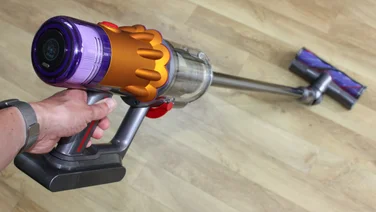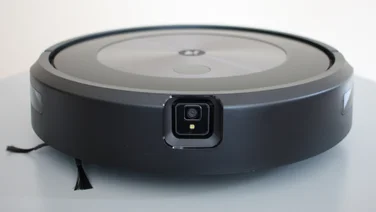To help us provide you with free impartial advice, we may earn a commission if you buy through links on our site. Learn more















- Easy-to-use app
- Good at finding its way around
- Fast and efficient
- Disappointing mop
- Average spot cleaner
The Ecovacs Deebot N10 robot vacuum cleaner brings a little of the magic of its big brother, the Deebot X1 Omni, to a more affordable robot vacuum. It uses the know-how from the Ecovacs app and has laser-accurate LiDAR navigation so is able to clean your floors efficiently and automatically.
This basic model doesn’t self-empty, though, and has a significantly more basic mopping function than its more expensive stablemate. Despite those shortcomings, it’s still a reliable robot vacuum at a decent price.
Ecovacs Deebot N10 review: What do you get for the money?
The Ecovavs Deebot N10 comes in two versions, the basic N10 (with an RRP of £399) and the self-emptying N10+ (£549). I was sent the N10 to review, so haven’t tested the self-emptying capability.
Apart from the docking stations, the two units are the same. The vacuum cleaner itself is wide at 350mm across its diameter, but fairly short at only 93mm to the top of its turret. Most turreted LiDAR robot vacuum cleaners I’ve tested can’t make it under the low shelf of my coffee table, but this one can.
The collection bin is located under a flap on the top of the robot, where you’ll also find the on/off switch and the pairing button, which you’ll only need during setup. The collection bin is 420ml, which is a reasonable size but is still likely to need emptying regularly if it’s cleaning an average-sized house.















When you want to use the mopping function, there’s a separate 240ml reservoir, which you fill with water and clip onto the back. Attached to the base of this is a reusable cloth, which is moistened from the reservoir and dragged along at the rear of the robot. This is more of a light wipe than a proper mopping.
The N10 comes with a small innocuous dock that needs to be located up against a wall in a space where it can be easily accessed by the robot. If you opt for the N10+ instead, you’ll need a bit more room to house the self-emptying base.
READ NEXT: The best Dyson vacuums to buy
Ecovacs Deebot N10 review: What is it like to use?
A successful robot vacuum cleaner needs a decent smartphone app. With the Deebot N10, Ecovacs has slotted the robot into its existing app (available for Android and iOS), so you’re getting the same core experience as you would if you were installing the high-end Deebot X1 Omni.
This makes for a compelling proposition, and the device is simple to set up and get started with. Once you’ve got going and your map has been created, you can modify it as you wish, adding no-go areas and virtual boundaries. You can also section off rooms if the app hasn’t got it quite right – it’s good at spotting room changes between doorways but might need help with open-plan areas.















The app can be used to configure cleans to happen automatically on a schedule, and you can fine-tune these as much as you like. You can set the order rooms are cleaned, choose which rooms to clean, and send it to clean specific areas if you don’t need to do the whole house. You can also set areas for the mop to ignore if the attachment is on.
The app also manages multiple maps very well, making it good for multi-storey households. Its only foible is that you have to move the charging station to the new floor when you want it to start mapping. It doesn’t need to stay there, but it won’t create its initial map properly without it.
When you move the robot subsequently, it performs a short location check before it starts, scanning the room it’s in for familiar features. This means it doesn’t matter where it starts or on what floor – it will locate itself on the appropriate stored map and start work















After cleaning with the standard N10 model, you’ll need to empty the collection bin yourself. This is a simple case of lifting the lid on the back of the robot, pulling out the collection bin and taking it to your dustbin. There’s a button on the side that opens a door, which lets the dirt fall out. It has a mesh over the concertina filter, so does a good job of keeping itself relatively clean.
Ecovacs Deebot N10 review: Is it good at finding its way around?
I was genuinely impressed with how gentle the Ecovavs Deebot N10 is around solid obstacles. It uses a mixture of infrared sensors and the ability to gently nudge into solid objects with its bumper. However, even the bumper is extremely light touch. In my tests, it happily vacuumed around some floor-length curtains, barely nudging them before gently circling its way around them.
What it can’t do is avoid general floor detritus, such as socks, cables and pet mess, so you need to ensure your floor is clear before you send it around. If you want a robot that can do this, consider the iRobot Roomba j7.















The LIDAR navigation is excellent. In general room-by-room vacuuming mode, it first cleans around the edge, then traverses across the room in straight lines, turning around and coming back again in the opposite direction a little further along. This is repeated until all of the floor is covered, at which point it moves on to the next room.
My ground floor has a relatively tricky layout that’s a sort of ‘C’ shape, so robots have to go back on themselves in order to work their way back from the end of the clean to the charging station. This wasn’t a problem for the N10 – it found a clear path that looped it around walls and easily navigated doorways to get back to its charging station via a very direct route.















If you don’t want the robot to enter particular rooms you can block them with virtual boundaries. I performed the first mapping with one door closed, then opened it later on a subsequent clean. The robot took this into its stride and introduced the new room onto its map on a later pass without any complications.
I also found it capable of mounting solid obstacles, such as thicker doormats, without any problems. It didn’t get stuck around chair or table legs and is generally an excellent navigator.
Ecovacs Deebot N10 review: How well does it clean?
In general vacuuming, the Ecovacs Deebot N10 performed well. It left carpet looking fresh and clean and tackled hard floors just as well. It covers ground quickly, too, taking around a minute per square metre.
Its general cleaning ability wasn’t particularly well reflected in our spot cleaning tests, mostly because of the way that spot cleans are tackled. The best performers tend to be those that you can place on top of a mess and then program to spiral outwards to gather as much as possible. Ironically, models that rely on this method are often the worst navigators.















The N10 doesn’t have a standard spot clean option, instead, you have to use the app to draw a rectangle on the map that contains the mess. This sends the robot out to the marked area, which it treats like a little room – it goes around the edges, then fills in the shape by traversing in straight lines.
The problem with this is that there’s a chance the wheels and sweepers have hit the mess before it comes into contact with the suction inlet. This can cause scatter and treading in, which makes it harder work for the brush roller and suction.
We test robot vacuum cleaners by dropping measured quantities of rice and flour onto both hard floor and carpet. By weighing how much the robot has collected, we can compare the performance of all the robot vacuums we’ve tested.















Its best result was collecting rice from carpet, where it collected 98% of my test spillage. The advantage here is that rice doesn’t scatter too far when hit by the sweepers, and it doesn’t get picked up by the robot’s wheels or trodden into the carpet. On a hard floor, where the rice is prone to scattering further, it collected 82% of the rice, though the remainder was pushed out of the robot’s reach.
The N10 collected the same amount of flour from our hard floor test, again picking up 82% of the spillage I created. Much of what wasn’t collected was picked up on the wheels and deposited back on the floor in tyre tracks. It was messier collecting flour from carpet. Here it only managed to gather 56% of the flour, with the rest left behind.
Overall, that leaves it performing below average in our tests. However, this isn’t a terrible score for this kind of robot vacuum, which is better at covering a whole house than it is at targeting concentrated spillages.

That leaves us with the mopping. Here I was more disappointed. During my tests, I had to push the mop’s settings up to maximum to get enough water flowing through the system to make the floor look like it was using enough water to give it a clean. I also found it worked best when programmed to ‘deep’ clean, which makes the parallel lines along which it mops closer together. This slows the progress of the mop, though, making it slower than when it’s vacuuming.
In practice, it did provide some light wiping, but it wasn’t enough to lift dried-on dirt in a single mopping session. Compared to the admittedly more expensive Deebot X1 Omni, which uses spinning mop pads to get more moisture and movement onto the floor, this dragged cloth method of mopping is as disappointing as ever.
Ecovacs Deebot N10 review: Should I buy it?
While the Ecovacs Deebot N10 isn’t the best-performing spot cleaner we’ve seen for the price, it did a decent job of regular vacuuming. This is helped significantly by its easy-to-use app and sensible approach to navigation. It can cover even complex floor plans quickly and efficiently, operate on multiple storeys, and be set to work when it suits you.
Its mopping ability proved a little disappointing but that’s often the case with this style of mop attachment, which essentially drags a damp cloth along behind the vacuum as it goes. That’s passable for loose dirt but isn’t going to stop you from having to get the manual mop out every now and then to give the floor a proper clean.
If it’s mopping you’re after, the Ecovacs Deebot X1 Omni is the best robot mop we’ve reviewed to date, with spinning mop discs that create decent agitation. It also has a self-cleaning and emptying station with clean and dirty water reservoirs, but it’s not cheap.
One thing the Deebot N10 isn’t good at is detecting problematic items that might be lying around, such as socks, cables and pet mess. The iRobot Roomba j7 is a better bet here, as it can navigate around dropped items and you don’t have to start each vacuuming session with a tidy-up.
If spot cleaning performance is what you’re really looking for and your floorplans aren’t too complex, more affordable robots are available that can be dropped on top of problem areas for effective spot cleaning, but they aren’t usually as good at finding their way around. The Eufy RoboVac G20 is a good example: it’s great at clearing up piles of mess and is currently available for under £200.










